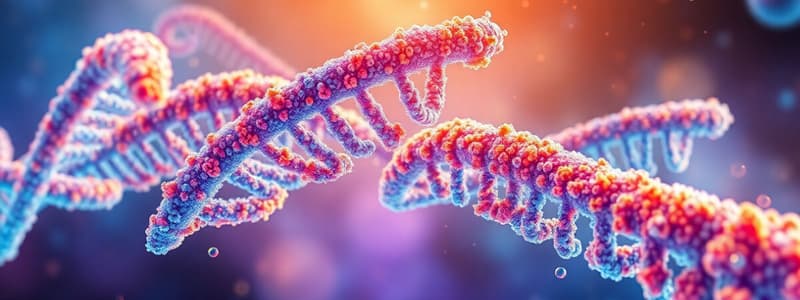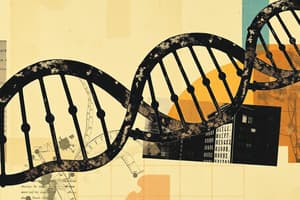Podcast
Questions and Answers
What enzyme is primarily responsible for DNA replication?
What enzyme is primarily responsible for DNA replication?
- DNA ligase
- Helicase
- DNA polymerase (correct)
- RNA polymerase
Which of the following statements about DNA replication is true?
Which of the following statements about DNA replication is true?
- It occurs only during cell division.
- It requires a template strand. (correct)
- It is a spontaneous process.
- It can happen without enzymes.
What is the main purpose of DNA replication?
What is the main purpose of DNA replication?
- To repair damaged genes
- To modify protein structures
- To transcribe RNA
- To make a copy of genetic information (correct)
During DNA replication, the function of helicase is primarily to?
During DNA replication, the function of helicase is primarily to?
Which phase of the cell cycle does DNA replication occur?
Which phase of the cell cycle does DNA replication occur?
What is the primary advantage of having multiple origins of replication in eukaryotic DNA?
What is the primary advantage of having multiple origins of replication in eukaryotic DNA?
What is the result of the replication process in eukaryotic cells?
What is the result of the replication process in eukaryotic cells?
Why is it essential to shorten the total time for DNA replication in eukaryotic cells?
Why is it essential to shorten the total time for DNA replication in eukaryotic cells?
What does not describe a characteristic of eukaryotic DNA replication?
What does not describe a characteristic of eukaryotic DNA replication?
What could result from the lack of multiple origins of replication in eukaryotic DNA?
What could result from the lack of multiple origins of replication in eukaryotic DNA?
What does a codon consist of?
What does a codon consist of?
How many nucleotides specify each amino acid?
How many nucleotides specify each amino acid?
Where does mRNA go after leaving the nucleus?
Where does mRNA go after leaving the nucleus?
Which step is NOT part of the translation process?
Which step is NOT part of the translation process?
What is the role of a codon in protein synthesis?
What is the role of a codon in protein synthesis?
What is the primary purpose of transcription in protein synthesis?
What is the primary purpose of transcription in protein synthesis?
Which location does translation primarily occur in a cell?
Which location does translation primarily occur in a cell?
What is the significance of having one old strand and one new strand in each new DNA helix?
What is the significance of having one old strand and one new strand in each new DNA helix?
Which of the following RNA molecules is responsible for bringing amino acids to the ribosome during translation?
Which of the following RNA molecules is responsible for bringing amino acids to the ribosome during translation?
What is produced as the final product of translation?
What is produced as the final product of translation?
Which statement best describes DNA replication based on the information provided?
Which statement best describes DNA replication based on the information provided?
Which statement best describes the function of ribosomal RNA (rRNA) in protein synthesis?
Which statement best describes the function of ribosomal RNA (rRNA) in protein synthesis?
What kind of molecules are produced during DNA replication?
What kind of molecules are produced during DNA replication?
What does the term 'daughter DNA molecules' refer to in the context of DNA replication?
What does the term 'daughter DNA molecules' refer to in the context of DNA replication?
Which characteristic of DNA replication is NOT mentioned in the content provided?
Which characteristic of DNA replication is NOT mentioned in the content provided?
Study Notes
DNA replication
- The process of creating a copy of DNA
- Catalyzed by an enzyme called DNA polymerase
- Necessary for cell division and growth
- Eukaryotic DNA has multiple origins of replication, speeding up the process.
- Results in two daughter DNA molecules, each with one old strand and one new strand.
Protein Synthesis
- The process of creating proteins from DNA.
- Requires transcription and translation.
Transcription
- The process of creating messenger RNA (mRNA) from DNA.
- Occurs in the nucleus.
- mRNA carries the genetic code from DNA to the ribosome.
Translation
- The process of synthesizing proteins from mRNA.
- Occurs in the ribosomes.
- Requires three types of RNA
- Messenger RNA (mRNA)
- Ribosomal RNA (rRNA)
- Transfer RNA (tRNA)
Summary
Transcription
- Definition: Copying DNA into mRNA
- Purpose: To transfer genetic information from DNA to a format that can be used for protein synthesis
- Products: mRNA
- Location: Nucleus
Translation
- Definition: Creating proteins from mRNA
- Purpose: To synthesize proteins
- Products: Proteins
- Location: Ribosomes
Studying That Suits You
Use AI to generate personalized quizzes and flashcards to suit your learning preferences.
Related Documents
Description
Test your knowledge on DNA replication and the intricate process of protein synthesis. This quiz covers key concepts including transcription, translation, and the roles of different types of RNA. Understanding these processes is essential for grasping fundamental biological functions.




